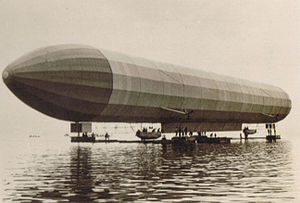LZ 2
| LZ 2 | |
|---|---|
 | |
| Role | Experimental airship Type of aircraft |
| National origin | Germany |
| Manufacturer | Luftschiffbau Zeppelin |
| Designer | Ludwig Dürr |
| First flight | 17 January 1906 |
| Number built | 1 |
The LZ 2 was a German experimental airship constructed by Luftschiffbau Zeppelin and first flown in 1906. It was the true ancestor of later Zeppelin airship designs. The major mistakes made by Kübler in the design of the LZ 1 were not repeated: the designer, Ludwig Dürr, who was to head the design of all subsequent Zeppelins, used triangular-section girders instead of Kübler's flat girders, and elevators instead of a lead weight to control pitch.[1][2] The life of the LZ 2 was brief, consisting of only two flights. Its near-sister ship, the LZ 3—which first flew on 9 October 1906—was purchased by the German Army and operated as the Z I until 1913.[3] Before being purchased by the Army, LZ 3 made many flights and carried a number of prestigious passengers, including the German Crown Prince.[4]
Specifications
Data from Robinson 1973 pp.29-30
General characteristics
- Length: 126.19 m (414 ft 0 in)
- Diameter: 11.75 m (38 ft 6 in)
- Volume: 10,370 m3 (366,200 cu ft)
- Powerplant: 2 × Daimler piston engines , 63 kW (84 hp) each
Performance
- Maximum speed: 40 km/h (25 mph, 22 kn)
- Range: 1,100 km (680 mi, 590 nmi)
- Service ceiling: 850 m (2,800 ft)
References
- ^ Robinson, Douglas H. (1973). Giants in the Sky. Seattle: University of Washington Press. p. 29. ISBN 0-295-95249-0.
- ^ Brooks, Peter W. (1992). Zeppelin: Rigid Airships 1893-1940. Washington D.C.: Smithsonian Institution Press. pp. 34–35. ISBN 1-56098-228-4.
- ^ Brooks, Peter W. (1992). Zeppelin: Rigid Airships 1893-1940. Washington D.C.: Smithsonian Institution Press. p. 34. ISBN 1-56098-228-4.
- ^ Robinson, Douglas H. (1973). Giants in the Sky. Seattle: University of Washington Press. p. 34. ISBN 0-295-95249-0.
Bibliography

- Stephenson, Charles (2004). Zeppelins: German Airships 1900-40. Oxford: Osprey.
- v
- t
- e
(airships)
| Manufacturer hull numbers |
| ||||||||||||||||||||||||||||||||||||||||||||||||||||
|---|---|---|---|---|---|---|---|---|---|---|---|---|---|---|---|---|---|---|---|---|---|---|---|---|---|---|---|---|---|---|---|---|---|---|---|---|---|---|---|---|---|---|---|---|---|---|---|---|---|---|---|---|---|
| Operator's identification |
|
(aeroplanes)
| Zeppelin-Staaken | |
|---|---|
| Zeppelin-Lindau | |
| Zeppelin Flugzeugebau | |
| Other |












